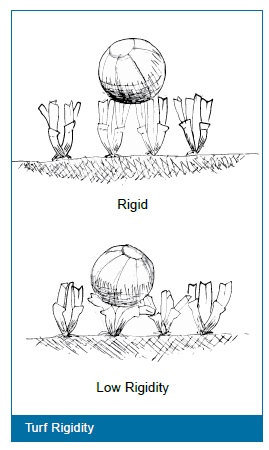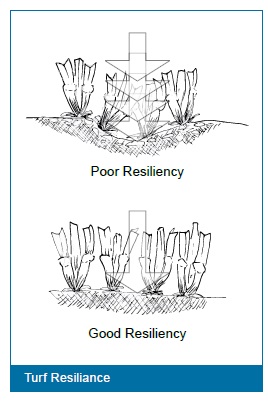Sneak Peek
Lawn Mowing & Turf Care
Self Paced 20-hour course to help you understand more about turf.
Learn more about mowing and other turf care practices; and be a much better turf professional.
Managing turf is more than just keeping the grass short however in some cases (as contractors) that is all we are asked to do, just mow the grass. When dealing with finer lawns or turf that is used for specific purposes such as sporting grounds or those in large and elegant gardens, we need more information and more knowledge. In those instances we need to be able to assess lawns and how the soil, light, temperature, air, water and traffic affect the quality of the turf. In any situation, we will do a better job if we know more about the turf and techniques for it’s care – then apply that knowledge.
Our 20 hour courses are self paced and will help you understand a topic in a short amount of time. You can work through the course when you like- test yourself with mini-tests along the way. There are extra case studies or research you can undertake if you would really like to get into the topic. Once you have completed the lessons and self assessment tasks, there is a final exam undertaken online- you can then download your personalised certificate.
COURSE CONTENT- What do you learn?
There are 5 lessons as follows:
Lesson 1 TURF QUALITY
- What varieties
- In unexpected drought conditions
- Evaluating turf quality and needs
Lesson 2 MOWING
- Mowing calculations
- Basic calculations
- Mowing
- Understanding how grass grows
- Understanding how lawn mowers cut grass
- Other considerations for mowers
- How to mow grass
- Before you mow
- Length of cut
- Direction of cut or pattern of cutting
- Other considerations
- Mowing newly established turf
- Raking before cutting?
- Collecting grass clippings
- Summary of points
- Cutting steep slopes
- Using growth regulators
- Problems that may occur by mowing
- Mowing safety
- Mowing and its impact on the environment
Lesson 3 MAINTAINING TURF QUALITY
- Maintaining turf
- Maintenance tasks
- Turf/lawn aeration
- Soil pH
- Other ways to improve soils
- Weeding
- Dealing with pest and diseases
- Environmental problems in turf
- Watering
Lesson 4 TURF EQUIPMENT AND TOOLS
- Types of mowing equipment
- Cylinder mowers
- Rotary mowers
- Tractor mounted
- Ride on mower
- Push type mowers
- Hover mowers
- Options for power
- Deciding what you need
- Mower maintenance
- Electric mowers
- Petrol mowers
- Changing mower blades
- Other turf maintenance equipment
- Edger
- Leaf rakes/vacuums
- Forks
- Rollers
- Wheelbarrows
- Strimmer/brush cutter/whipper snipper
- Spray equipment
- Should you buy, lease or hire?
Lesson 5 TURF BUSINESS MANAGEMENT
- Starting your business
- Before you start
- Be informed
- Developing a customer base
- Location
- Employees
- Equipment
- Finance
- Buying into a franchise
- Avoiding disputes
- Other services you might offer
- Legal requirements
- Professional advice
- Keeping business records
- Taxation
- Understanding contract law
- Developing your business
- Managing growth

START BY UNDERSTANDING TURF QUALITY
Managing turf is more than just keeping the grass short however in some cases (as contractors) that we are asked to do, just mow the grass. When dealing with finer lawns or turf that is used for specific purposes such as sporting grounds or those in large and elegant gardens, we need more information and more knowledge. In those instances we need to be able to assess lawns and how the soil, light, temperature, air, water and traffic affect the quality of the turf.
There are many different criteria you may choose to use for evaluating turf – all are complex and conditional and depend on the factors you consider and the weight you give to each:
- Amenity/functionality
- Health
- Sustainability
- Cost – establishment, maintenance
Traditionally turf grass quality has been evaluated on the basis of appearance and health by making an inspection of the site on the ground. This is still the case for many lawn areas, especially domestic ones. Modern technologies such as drones and digital imaging (still in the research phase at this stage) and other established techniques have given us further options for making evaluations of turf quality – especially for larger expanses and facilities.
Some of these techniques (eg. digital imaging) are outside of the scope of most people who mow lawns, especially domestic lawns. They require special equipment and quite scientific techniques.
Established techniques used today for determining lawn quality include the use of:
- Impact testers to evaluate surface hardness
- Penetrometers to evaluate soil against a compaction index
- Core samplers which can analyse the root depth and root percentage
- Moisture meters and infiltration devices (which measure water infiltration)
- Surface traction devices
- Laser devices for surface levels
- Quadrats which measure the percentage of ground cover and also the weed content of a site.
Visual rating systems, however, are also still used, in many cases.

What to Look for
- Indicators of Quality might include such characteristics as:
- Function – how a ball rolls or bounces, grip, slipperiness, glare/light reflection, softness.
- Uniformity – appearance, plant cultivars, texture, colour, health, smoothness.
- Texture – from fine to coarse; in domestic applications this is often linked to preference in a sporting application this will be determined by use.
- Density – the density of a sward helps to crate even and thick ground cover, dense turf is not as prone to weed infestation.
- Turf age – as turf ages it can become depleted
- The species or cultivars used if known – this will help determine if the correct species has been used for the purpose and what that variety needs in the way of maintenance.
- Growth habit of the species used – this helps determine mowing and maintenance programs.
- Water requirements; different soils have differing water holding abilities.
- The (measured) physical area of turf in question.
- Drainage patterns of the site helps to determine where water will accumulate and how much is lost to run-off.
- Irrigation equipment – what is used and when it is used.
- Pests and diseases - injury and tolerance – some varieties are more tolerant of pest and disease injury than others. Knowing the varieties tolerance will help to determine pest and disease prevention programs.
- Environmental problems and tolerance e.g. drought and cold winter conditions and weather events causing turf damage.
- Seasonal changes (this helps to determine whether changes in colour is a result of normal changes in the season or because of pest, disease or environmental impacts.
- Traffic tolerance – compaction by vehicles, equipment and foot traffic which can occur over years or months of use.
- Wear injury – this usually occurs immediately after use e.g. after a game.
- Weed intrusion – weeds often intrude into open swards and during times when the turf is under stress e.g. prolonged dry periods when the turf thins out or browns off.
- Light – the amount of light a turfed area receives determines the species that should be used and the condition of the grass if the species is not shade tolerant.
- Thatch accumulation – this can very time consuming to establish it occurs to several turf species and is usually measured by placing a 1kg weight on the affected turf and measuring the compacted depressed turf in millimetres.

WHO IS THIS COURSE FOR?
- Gardeners – Tradesmen
- Horticulturists
- Turf Industry Employees (Mower shops, turf farms, etc)
- Parks Staff
- Sportsground Staff
- Mowing Contractors
- Home Gardeners
- Students
- Anyone planning to buy or establish a mowing business
How does this course work?
You can enrol at any time.
Once you have paid for the course, you will be able to start straight away.
Study when and where you like. Work through at your own pace.
You can download your study-guide to your smart phone, tablet or laptop to read offline.
There are automated self-assessment tests you can complete at the end of each lesson. You can attempt these as many times as you wish and each time, upon completion, you can see your results. You will need internet access to complete the self assessment tests.
At the end of the course, you are presented with a large assessment which can be attempted online, anywhere, anytime. If you achieve a 60% pass in the exam; you immediately receive a downloadable certificate of completion with your name on it. If you do not achieve a 60% pass rate, you can contact us to re-sit your exam. ( email- admin@acs.edu.au )
Contact us at anytime if you have any issues with the course. admin@acs.edu.au